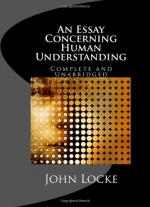|
This section contains 8,681 words (approx. 29 pages at 300 words per page) |

|
SOURCE: "Seascape with Fog: Metaphor in Locke's Essay," in Journal of the History of Ideas, Vol. LIV, No. 1, January, 1993, pp. 1-18.
In the following essay Vogt explores the use of metaphor in An Essay Concerning Human Understanding, arguing that Locke's imagery and meaning are far more varied, complex, and "probabilistic" than the straightforward empiricism suggested by the famous tabula rasa image.
No image from John Locke's philosophical work is as widely recognized as that of the white paper, the famous tabula rasa. But calls by Dominick LaCapra and other similarly minded theorists of history for a rereading of such "great texts" as An Essay Concerning Human Understanding raise the problem of whether this particular metaphor is a suitable synecdoche for Locke's complete philosophy of mind.1 The same problem emerges both from reappraisals by historians of science of the "experimental method" developed within the Royal Society by an intellectual...
|
This section contains 8,681 words (approx. 29 pages at 300 words per page) |

|


